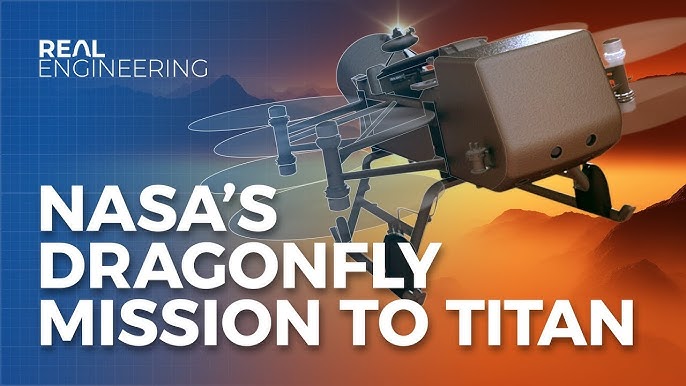Washington, USA#
NASA has announced the launch of its groundbreaking Dragonfly mission, set to explore Saturn’s largest moon, Titan, in search of the building blocks of life. Scheduled to launch in July 2028 aboard a SpaceX Falcon Heavy rocket, the mission aims to unravel the secrets of one of the most Earth-like celestial bodies in our solar system.
Titan, often described as a “frozen Earth,” boasts a thick nitrogen-rich atmosphere, lakes and rivers of liquid methane, and a subsurface ocean of liquid water—making it a prime candidate for studying prebiotic chemistry and potential habitability.
NASA’s Dragonfly mission is a robotic rotorcraft that will explore Titan, Saturn’s largest moon. The mission’s goal is to study the moon’s chemistry and habitability to learn more about the origins of life.
A Revolutionary Rotorcraft Lander
Unlike traditional landers or rovers, Dragonfly is a rotorcraft equipped with eight rotors, designed to fly across Titan’s diverse terrain. The mission represents NASA’s first interplanetary exploration using a drone-like aircraft.
“Dragonfly will revolutionize how we explore alien worlds,” said Dr. Thomas Zurbuchen, NASA’s Associate Administrator for Science. “Its ability to fly allows us to cover far greater distances than a rover, opening up new possibilities for discovery.”
Mission Objectives
Over its planned 2.5-year mission, Dragonfly will conduct detailed scientific investigations, including:
Analyzing Surface Chemistry: Studying Titan’s organic-rich crust to identify complex molecules and prebiotic chemistry.
Searching for Habitability: Assessing whether Titan’s environment could support microbial life.
Investigating Selk Crater: A primary target, the crater is believed to have hosted liquid water, heat, and organic materials in the past. Studying Atmospheric and Geological Processes: Examining Titan’s methane cycle and interactions between its surface and dense atmosphere.
Key Features and Instruments
Dragonfly will be powered by a Multi-Mission Radioisotope Thermoelectric Generator (MMRTG), ensuring reliable energy in Titan’s frigid environment. It will carry cutting-edge scientific instruments, including:
DraMS (Dragonfly Mass Spectrometer): For analyzing organic materials.
DraGMet: A meteorology and geophysics package to study atmospheric pressure, temperature, and seismic activity.
Cameras: To capture high-resolution images of Titan’s landscape.
The rotorcraft will traverse up to 110 miles (180 kilometers), hopping between scientifically significant sites to collect data.
Why Titan?
Titan stands out as a unique destination for astrobiological studies:
It has a dense atmosphere similar to early Earth. Lakes, rivers, and seas of liquid methane flow on its surface.
Organic compounds and a subsurface ocean of water suggest conditions favorable for life.
Timeline and Global Impact
The spacecraft is expected to arrive at Titan in 2034 and will focus on unlocking the moon’s potential to support life. Scientists believe the data from Dragonfly could offer insights not only into the origins of life on Titan but also on Earth.
“Titan is a natural laboratory for studying the building blocks of life,” said Dr. Elizabeth Turtle, the mission’s principal investigator. “With Dragonfly, we’ll explore worlds of possibility.”
A Giant Leap for Space Exploration
Dragonfly is part of NASA’s New Frontiers Program, which has previously delivered iconic missions such as New Horizons (Pluto) and Juno (Jupiter). The $1 billion mission will mark a bold step in interplanetary exploration, paving the way for future extraterrestrial studies.##



মন্তব্যসমূহ বন্ধ করা হয়.